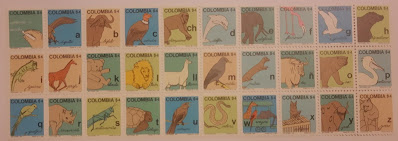It took me a while, but finally I was able to find the complete set of the alphabet, used in Colombia.
The alphabet is the same as in all Spanish-speaking countries, and is the standard Latin alphabet, extended with some additional characters.
I could call it the 'Spanish' alphabet, but since the stamps are issued in Colombia, I'll name it the 'Colombian alphabet'.
The set consists of 30 stamps; 29 with characters and one with the message 'Learn to write'.
The set comes in 3 rows of 10 stamps each.
 |
| 30 stamps on the 'Colombian alphabet' |
 |
| A for Águila, B for Búfalo, C for Cóndor |
The 'CH' is considered a separate consonant, written with two letters
C+H. The word 'chimpancé' is pronounced the same as in English.
Also the 'LL' is unknown in the English alphabet. In Spain it will be pronounced as 'lj' but in South America 'sj' is a more common way to pronounce the 'LL'.
If the animal is named 'lama' you could say in Spanish : la llama se llama Llama...
 |
| N and Ñ |
Also typical for the Colombian (Spanish) alphabet is the 'Ñ' which we see in the country name 'España'. Because the 'ñ' is so typical for the alphabet, it is nowadays used on spanish stamps as a security mark.
The 'ñ' is cut out of many stamps as a security mark.
 |
| the 'ñ' cut out of the stamp |
The full set of 30 stamps has been given a catalogue value of € 30, about $ 1 each.
to be continued...










